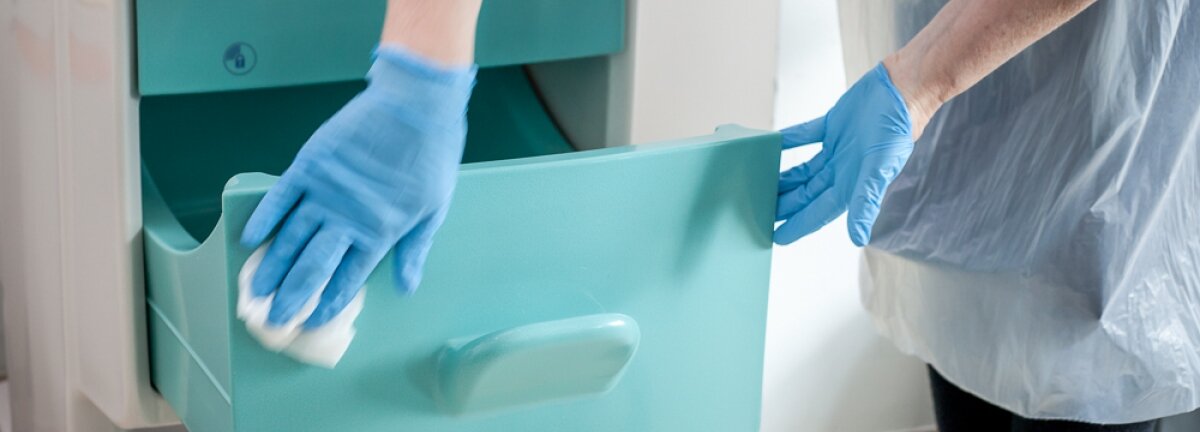Design Bugs Out

Launched in August 2008, Design Bugs Out was a design challenge run in partnership with the Department of Health and the NHS Purchasing and Supply Agency. Its aim was to bring designers and manufacturers together with clinical specialists, patients and frontline staff to help combat infections by making hospital furniture and equipment easier and quicker to clean.
On looking at the various items of hospital equipment most likely to spread infection, our simple insight was that they were difficult to clean.
Mat Hunter, Chief Design Officer, Design Council
The problem
Healthcare Associated Infections (HCAIs) are infections acquired in hospitals or due to healthcare interventions. They are caused by a wide variety of micro-organisms, including bacteria that normally live harmlessly in or on our bodies. The National Audit Office estimates that 5,000 people die each year from infections such as MRSA, and that this costs the NHS £1bn a year.
Historically, items of hospital furniture have primarily been designed for functionality and little attention has been paid to the cleanability of the products. To complement the Department of Health’s wider approach to addressing the HCAI challenge, we set out to find design solutions for hospital furniture that could contribute towards preventing infection and make cleaning easier, taking into account the behaviour of hospital staff, patients and visitors.
The insight
Based on initial research with users, Design Council undertook a wide-ranging review of the clinical environment to identify areas that would benefit most from design input.
The team, including designers, ergonomists and researchers, visited a number of NHS hospitals and worked with patients, nurses, domestics and other staff to discuss issues and experience them firsthand.
This work identified 51 design opportunities, which were considered by a project Expert Reference Group (ERG) and Advisory Board.
These were shortlisted to ten opportunities in two streams: five ‘quick wins’ that were developed by the Helen Hamlyn Centre (Royal College of Art) and five that were advertised via a national design competition.
Our response
The national competition explicitly required bidding manufacturers to partner with a design firm. Four winning teams accessed a grant of £25,000 and worked with Design Council, the ERG and the Advisory Board to develop their product proposals.
The results
The resulting range of commodes, blood pressure cuffs, bedside cabinets and patient chairs are designed with fewer nooks, crannies and textures where bugs can hide.
Mat Hunter, Chief Design Officer, Design Council
The project led to the development of four pieces of furniture and equipment, specifically designed to eliminate dirt traps, make cleaning quicker and easier and, ultimately, reduce the incidence of HCAIs.
Mat Hunter, Chief Design Officer, at Design Council, says: “The resulting range of commodes, blood pressure cuffs, bedside cabinets and patient chairs are designed with fewer nooks, crannies and textures where bugs can hide. These products have successfully been procured and used in the NHS, saving countless lives from the threat of superbugs.”
Designers and manufacturers worked in conjunction with NHS users to create prototypes of the products for evaluation in eight showcase hospitals. The products comprised a commode, bedside cabinet, overbed table and patient chair.
Following rigorous assessments that replicated the routine hospital cleaning procedures of typically contaminated hospital furniture, the new products proved to be easier to clean and they are now available online in the NHS Supply Chain catalogue.
Stuart Davis, managing director of Bristol Maid, who designed a bedside cabinet, said that the NHS competition was the driving force behind the company’s eClean range. It now has a suite of six products developed as a direct result of the Design Bugs Out competition.
“That gave us the impetus to keep going and invest more,” says Stuart.
“The bedside cabinet was the initial success and received £25,000 of funding from the Department of Health but that gave us the faith to invest more heavily and become much more innovative and ambitious, realising there was desire and a market for these products.”
Full details of the evaluation of the furniture products can be downloaded from the Department of Health website.
Subscribe to our newsletter
Want to keep up with the latest from the Design Council?
